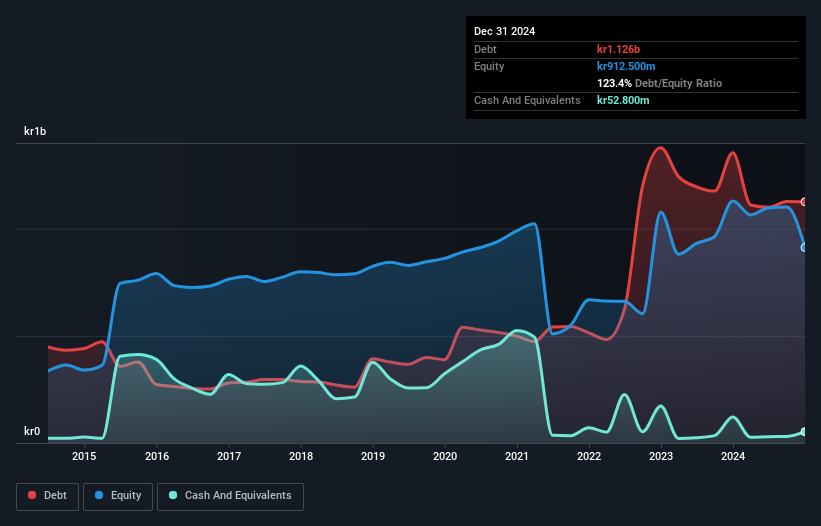
Howard Marks put it nicely when he said that, rather than worrying about share price volatility, 'The possibility of permanent loss is the risk I worry about... and every practical investor I know worries about.' So it seems the smart money knows that debt - which is usually involved in bankruptcies - is a very important factor, when you assess how risky a company is. As with many other companies Byggma ASA (OB:BMA) makes use of debt. But the more important question is: how much risk is that debt creating?
When Is Debt Dangerous?
Generally speaking, debt only becomes a real problem when a company can't easily pay it off, either by raising capital or with its own cash flow. Ultimately, if the company can't fulfill its legal obligations to repay debt, shareholders could walk away with nothing. However, a more frequent (but still costly) occurrence is where a company must issue shares at bargain-basement prices, permanently diluting shareholders, just to shore up its balance sheet. Having said that, the most common situation is where a company manages its debt reasonably well - and to its own advantage. The first step when considering a company's debt levels is to consider its cash and debt together.
How Much Debt Does Byggma Carry?
The image below, which you can click on for greater detail, shows that Byggma had debt of kr1.13b at the end of December 2024, a reduction from kr1.35b over a year. However, it does have kr52.8m in cash offsetting this, leading to net debt of about kr1.07b.

How Healthy Is Byggma's Balance Sheet?
The latest balance sheet data shows that Byggma had liabilities of kr1.04b due within a year, and liabilities of kr962.6m falling due after that. Offsetting this, it had kr52.8m in cash and kr358.8m in receivables that were due within 12 months. So its liabilities total kr1.59b more than the combination of its cash and short-term receivables.
When you consider that this deficiency exceeds the company's kr1.19b market capitalization, you might well be inclined to review the balance sheet intently. In the scenario where the company had to clean up its balance sheet quickly, it seems likely shareholders would suffer extensive dilution. The balance sheet is clearly the area to focus on when you are analysing debt. But it is Byggma's earnings that will influence how the balance sheet holds up in the future. So if you're keen to discover more about its earnings, it might be worth checking out this graph of its long term earnings trend .
View our latest analysis for Byggma
Over 12 months, Byggma made a loss at the EBIT level, and saw its revenue drop to kr2.2b, which is a fall of 2.5%. That's not what we would hope to see.
Caveat Emptor
Importantly, Byggma had an earnings before interest and tax (EBIT) loss over the last year. Indeed, it lost kr1.6m at the EBIT level. Considering that alongside the liabilities mentioned above make us nervous about the company. It would need to improve its operations quickly for us to be interested in it. It's fair to say the loss of kr259m didn't encourage us either; we'd like to see a profit. In the meantime, we consider the stock to be risky. When analysing debt levels, the balance sheet is the obvious place to start. But ultimately, every company can contain risks that exist outside of the balance sheet. These risks can be hard to spot. Every company has them, and we've spotted 2 warning signs for Byggma you should know about.
When all is said and done, sometimes its easier to focus on companies that don't even need debt. Readers can access a list of growth stocks with zero net debt 100% free, right now.
Valuation is complex, but we're here to simplify it.
Discover if Byggma might be undervalued or overvalued with our detailed analysis, featuring fair value estimates, potential risks, dividends, insider trades, and its financial condition.
Access Free AnalysisHave feedback on this article? Concerned about the content? Get in touch with us directly. Alternatively, email editorial-team (at) simplywallst.com.
This article by Simply Wall St is general in nature. We provide commentary based on historical data and analyst forecasts only using an unbiased methodology and our articles are not intended to be financial advice. It does not constitute a recommendation to buy or sell any stock, and does not take account of your objectives, or your financial situation. We aim to bring you long-term focused analysis driven by fundamental data. Note that our analysis may not factor in the latest price-sensitive company announcements or qualitative material. Simply Wall St has no position in any stocks mentioned.
About OB:BMA
Byggma
Manufactures and supplies building materials in Norway, Sweden, Denmark, Finland, the United Kingdom, and internationally.
Slightly overvalued very low.
Market Insights
Community Narratives




